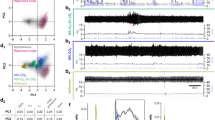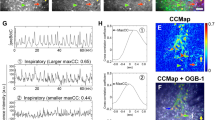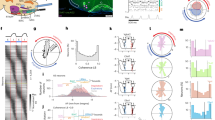Abstract
Are different forms of breathing derived from one or multiple neural networks? We demonstrate that brainstem slices containing the pre-Bötzinger complex generated two rhythms when normally oxygenated, with striking similarities to eupneic (‘normal’) respiration and sighs. Sighs were triggered by eupneic bursts under control conditions, but not in the presence of strychnine (1 μM). Although all neurons received synaptic inputs during both activities, the calcium channel blocker cadmium (4 μM) selectively abolished sighs. In anoxia, sighs ceased, and eupneic activity was reconfigured into gasping, which like eupnea was insensitive to 4 μM cadmium. This reconfiguration was accompanied by suppression of synaptic inhibition. We conclude that a single medullary network underlies multiple breathing patterns.
This is a preview of subscription content, access via your institution
Access options
Subscribe to this journal
Receive 12 print issues and online access
$209.00 per year
only $17.42 per issue
Buy this article
- Purchase on Springer Link
- Instant access to full article PDF
Prices may be subject to local taxes which are calculated during checkout








Similar content being viewed by others
References
Kahn, A. et al. Polysomnographic studies of infants who subsequently died of sudden infant death syndrome. Pediatrics 82, 721–727 (1988).
Poets, C. F., Meny, R. G., Chobanian, M. R. & Bonofiglo, R. E. Gasping and other cardiorespiratory patterns during sudden infant deaths. Pediatr. Res. 45, 350–354 (1999).
Lijowska, A. S., Reed, N. W., Chiodini, B. A. & Thach, B. T. Sequential arousal and airway-defensive behavior of infants in asphyxial sleep environments. J. Appl. Physiol. 83, 219–228 (1997).
Lumsden, T. Observations on the respiratory centres in the cat. J. Physiol. (Lond.) 57, 153–160 (1923).
St. John, W. M. Neurogenesis of patterns of automatic ventilatory activity. Prog. Neurobiol. 56, 97–117 (1998).
Smith, J. C., Ellenberger, H. H., Ballanyi, K., Richter, D. W. & Feldman, J. L. Pre-Bötzinger complex: a brainstem region that may generate respiratory rhythm in mammals. Science 254, 726–729 (1991).
Koshiya, N. & Guyenet. P. G. Tonic sympathetic reflex after blockade of respiratory rhythmogenesis in the cat. J. Physiol. (Lond.) 491, 859–869 (1996).
Fung, M. L., Wang, W. & St. John, W. M. Medullary loci critical for expression of gasping in adult rats. J. Physiol. (Lond.) 480, 597–611 (1994).
Huang, Q., Zhou, D. & St. John, W. M. Lesions of regions for in vitro ventilatory genesis eliminate gasping but not eupnea. Respir. Physiol. 107, 111–123 (1997).
Ramirez, J. M., Schwarzacher, S. W., Pierrefiche, O., Olivera, B. M. & Richter, D. W. Selective lesioning of the cat pre-Bötzinger complex in vivo eliminates breathing but not gasping. J. Physiol. (Lond.) 507, 895–907 (1998).
Meyrand, P., Simmers, J. & Moulins, M. Construction of a pattern-generating circuit with neurons of different networks. Nature 351, 60–63 (1991).
Marder, E. Polymorphic neural networks. Curr. Biol. 4, 752–754 (1994).
Ramirez, J. M. & Pearson, K. G. Generation of motor patterns for walking and flight in motoneurons supplying bifunctional muscles in the locust. J. Neurobiol. 19, 257–282 (1988).
Ramirez, J. M. Reconfiguration of the respiratory network at the onset of locust flight. J. Neurophysiol. 80, 3137–3147 (1998).
Grélot, L. & Bianchi, A. L. in Neural Control of the Respiratory Muscles (eds. Miller, A. D., Bianchi, A. L. & Bishop, B. P.) 297–304 (CRC Press, New York, 1997).
Ramirez, J. M., Quellmalz, U. J. & Wilken, B. Developmental changes in the hypoxic response of the hypoglossus respiratory motor output in vitro. J. Neurophysiol. 78, 383–392 (1997).
Ramirez, J. M., Telgkamp, P., Elsen, F. P., Quellmalz, U. J. & Richter, D. W. Respiratory rhythm generation in mammals: synaptic and membrane properties. Respir. Physiol. 110, 71–85 (1997).
Telgkamp, P. & Ramirez, J. M. Differential response of respiratory nuclei to anoxia in rhythmic brainstem slices of mice. J. Neurophysiol. 82, 2163–2170 (1999).
Orem, J. & Trotter, R. H. Medullary respiratory neuronal activity during augmented breaths in intact unanesthetized cats. J. Appl. Physiol. 74, 761–769 (1993).
Cherniack, N. S., von Euler, C., Glogowska, M. & Homma, I. Characteristics and rate of occurrence of spontaneous and provoked augmented breaths. Acta Physiol. Scand. 111, 349–360 (1981).
Haddad, G. G. & Jiang, C. O2 deprivation in the central nervous system: on mechanisms of neuronal response, differential sensitivity and injury. Prog. Neurobiol. 40, 277–318 (1993).
Neubauer, J. A., Melton, J. E. & Edelman, N. H. Modulation of respiration during brain hypoxia. J. Appl. Physiol. 68, 441–451 (1990).
Bartlett, D. Jr. Origin and regulation of spontaneous deep breaths. Respir. Physiol. 12, 230–238 (1971).
Wang, W., Fung, M. L., Darnall, R. A. & St. John, W. M. Characterizations and comparisons of eupnoea and gasping in neonatal rats. J. Physiol. (Lond.) 490, 277–292 (1996).
Wang, W., Fung, M. L. & St. John, W. M. Pontile regulation of ventilatory activity in the adult rat. J. Appl. Physiol. 74, 2801–2811 (1993).
Fung, M. L., Wang, W. & St. John W. M. Medullary loci critical for expression of gasping in adult rats. J. Physiol. 480, 597–611 (1994).
Lawson, E. E. & Thach, B. T. Respiratory patterns during progressive asphyxia in newborn rabbits. J. Appl. Physiol. 43, 468–474 (1977).
Macefield, G. & Nail, B. Phrenic and external intercostal motoneuron activity during progressive asphyxia. J. Appl. Physiol. 63, 1413–1420 (1987).
Ellenberger, H. H. Nucleus ambiguus and bulbospinal ventral respiratory group neurons in the neonatal rat. Brain Res. Bull. 50, 1–13 (1999).
Johnson, S. M., Smith, J. C., Funk, G. D. & Feldman, J. L. Pacemaker behavior of respiratory neurons in medullary slices from neonatal rat. J. Neurophysiol. 72, 2598–2608 (1994).
Rekling, J. C. & Feldman, J. L. PreBötzinger complex and pacemaker neurons: hypothesized site and kernel for respiratory rhythmogenesis. Annu. Rev. Physiol. 60, 385–405 (1998).
Koshiya, N. & Smith, J. C. Neuronal pacemaker for breathing visualized in vitro. Nature 400, 360–363 (1999).
St. John, W. M. Rostral medullary respiratory neuronal activities of decerebrate cats in eupnea, apneusis and gasping. Respir. Physiol. 116, 47–65 (1999).
Ramirez, J. M., Quellmalz, U. J., Wilken, B. & Richter, D. W. The hypoxic response of neurones within the in vitro mammalian respiratory network. J. Physiol. (Lond.) 507, 571–582 (1998).
Schmidt, C., Bellingham, M. C. & Richter, D. W. Adenosinergic modulation of respiratory neurones and hypoxic responses in the anaesthetized cat. J. Physiol. (Lond.) 483, 769–781 (1995).
England, S. J., Melton, J. E., Douse, M. A. & Duffin, J. Activity of respiratory neurons during hypoxia in the chemodenervated cat. J. Appl. Physiol. 78, 856–861 (1995).
Tomori, Z., Benacka, R. & Donic, V. Mechanisms and clinicophysiological implications of the sniff- and gasp-like aspiration reflex. Respir. Physiol. 114, 83–98 (1998).
Li, Y. Q., Takada, M., Kaneko, T. & Mizuno, N. Distribution of GABAergic and glycinergic premotor neurons projecting to the facial and hypoglossal nuclei in the rat. J. Comp. Neurol. 378, 283–294 (1997).
Solomon, I. C., Edelman, N. H. & Neubauer, J. A. Patterns of phrenic motor output evoked by chemical stimulation of neurons located in the pre-Bötzinger complex in vivo. J. Neurophysiol. 81, 1150–1161 (1999).
Dogas, Z. et al. Differential effects of GABAA receptor antagonists in the control of respiratory neuronal discharge patterns. J. Neurophysiol. 80, 2368–2377 (1998).
Richter, D. W. Generation and maintenance of the respiratory rhythm. J. Exp. Biol. 100, 93–107 (1982).
Haji, A., Takeda, R. & Remmers, J. E. Evidence that glycine and GABA mediate postsynaptic inhibition of bulbar respiratory neurons in the cat. J. Appl. Physiol. 73, 2333–2342 (1992).
Schmid, K., Foutz, A. S. & Denavit-Saubie, M. Inhibitions mediated by glycine and GABAA receptors shape the discharge pattern of bulbar respiratory neurons. Brain Res. 710, 150–160 (1996).
Brockhaus, J. & Ballanyi, K. Synaptic inhibition in the isolated respiratory network of neonatal rats. Eur. J. Neurosci. 10, 3823–3839 (1998).
St. John, W. M., Zhou, D. & Fregosi, R. F. Expiratory neural activities in gasping. J. Appl. Physiol. 66, 223–231 (1989).
Butera, R. J. Jr., Rinzel, J. & Smith, J. C. Models of respiratory rhythm generation in the pre-Bötzinger complex. I. Bursting pacemaker neurons. J. Neurophysiol. 82, 382–397 (1999).
Elsen, F. P. & Ramirez, J. M. Calcium currents of rhythmic neurons recorded in the isolated respiratory network of neonatal mice. J. Neurosci. 18, 10652–10662 (1998).
Gray, P. A., Rekling, J. C., Bocchiaro, C. M. & Feldman, J. L. Modulation of respiratory frequency by peptidergic input to rhythmogenic neurons in the preBötzinger complex. Science 286, 1566–1568 (1999).
Matsuishi, T. et al. Decreased cerebrospinal fluid levels of substance P in patients with Rett syndrome. Ann. Neurol. 42, 978–981 (1997).
Obonai, T. et al. Relationship of substance P and gliosis in medulla oblongata in neonatal sudden infant death syndrome. Pediatr. Neurol. 15, 189–192 (1996).
Acknowledgements
We would like to thank Dawn Blitz for reading an earlier draft of this manuscript. We would also like to thank Katherine Nagel for her contribution to some earlier strychnine experiments. This work was supported by NIH RO1-HL 60120-01A1. S.P.L. was supported by NIGMS Medical Scientist National Research Award 5 T32 GM07281.
Author information
Authors and Affiliations
Corresponding author
Rights and permissions
About this article
Cite this article
Lieske, S., Thoby-Brisson, M., Telgkamp, P. et al. Reconfiguration of the neural network controlling multiple breathing patterns: eupnea, sighs and gasps. Nat Neurosci 3, 600–607 (2000). https://doi.org/10.1038/75776
Received:
Accepted:
Issue Date:
DOI: https://doi.org/10.1038/75776
This article is cited by
-
Latent neural population dynamics underlying breathing, opioid-induced respiratory depression and gasping
Nature Neuroscience (2024)
-
Purinergic signaling mediates neuroglial interactions to modulate sighs
Nature Communications (2023)
-
Parabrachial tachykinin1-expressing neurons involved in state-dependent breathing control
Nature Communications (2023)
-
Modulation of inspiratory burst duration and frequency by bombesin in vitro
Pflügers Archiv - European Journal of Physiology (2023)
-
Temporal variations in the pattern of breathing: techniques, sources, and applications to translational sciences
The Journal of Physiological Sciences (2022)



